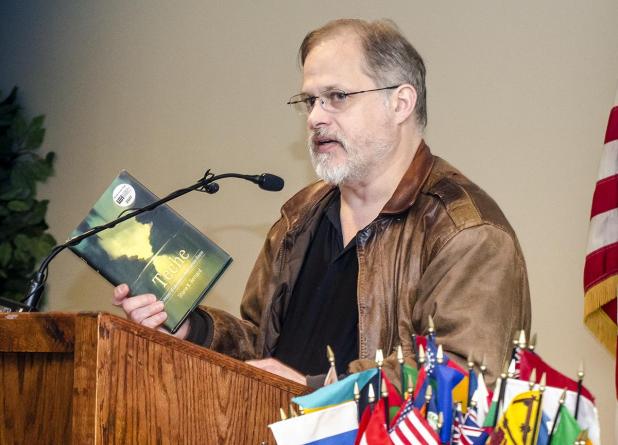
Teche
By CASEY COLLIER
Author and Historian Shane K. Bernard spoke with Franklin Rotary Tuesday concerning the subject of his latest book, Teche: A History of Louisiana’s Most Famous Bayou.
Bernard holds a Ph.D. in history from Texas A&M University, as well as degrees in history and English from the University of Louisiana at Lafayette.
His address included a brief history of the Bayou Teche from a cultural anthropological viewpoint, and how Franklin played into such a history, as well as touched on the future of the Teche, if not kept in proper stewardship.
Bernard said he wrote his book about the Teche based on three points that make it historically important to Louisiana.
“One is that it was a primitive superhighway leading into Central and South-Central Louisiana,” Bernard said, which aside from being invaded three times, was also “an incubator for settlers,” insofar as a first generation of settlers would settle on the bayou, with subsequent generations “spreading out from there.”
The third anchor-point for Bernard’s research he said was, “It (the Teche) was a center of commerce and wealth, especially during the period from 1830 to the Civil War.”
In discussing the “strange and interesting things” about the Teche which he observed through his research, the first thing Bernard mentioned was the history of the name of the bayou: Teche.
He said he could not find concrete evidence supporting why the bayou was named Teche. But, he traced its first reference back to the Chitimacha Tribe of Louisiana, who referred to it as “Snake Bayou,” based on an oral tradition in which tribal warriors fought a giant serpent, and slew it; the bayou being created by the serpent’s death throws.
However, Bernard stated that the Chitimacha word for Bayou Teche sounds nothing like “Teche,” nor could he find any regional tribe with a word that did sound like “Teche.”
He said, “Who knows? I’m completely agnostic on the origin of the name Teche. I don’t know where it came from and we may never know.”
Yet, he went on to say the first record of the name appeared in a document dated July 16, 1765.
According to Bernard, a settler living near New Iberia wrote a letter to the French caretakers of the region. In the letter, the settler expressed displeasure at having had squatters, who called themselves Acadians, settle on land on which he was also, in effect, a squatter, but which was where he had made his home, nonetheless. He requested a letter from the caretakers that would formally recognize him as the owner of the land, thereby granting him authority to evict the Acadians.
Bernard said the response from the French contained the word "Teche" for the first time, in description of the bayou, though they spelled it: Teiche.
In reference to the course of the bayou and the commerce which it conveyed between 1830 and 1940, Bernard pointed to “steamboats up to 150 ft. long, to ply up and down the Teche.”
He said some of the steamboats were longer than the Teche is wide, for much of its length.
“So, these steamboats couldn’t just turn around anywhere,” he said. “They had to wait until they got to an artificial turning basin at towns like Franklin, St. Martinville and New Iberia.”
He also said the locals of these towns called the basins, “demi-lunes,” or “half-moons” accounting for the shape the basins usually took.
In discussing the cultural heritage of Franklin as it pertains to the Teche and European settlement, Bernard said, “If you drive your boat along the Teche, from its origin in Port Barre, to Patterson, where it ends, you’ll notice that the culture becomes less French and Spanish, and more English and Scotch-Irish. Even the architecture changes a little bit.”
According to Bernard, that cultural differentiation could be estimated to take place in the area just south of Jeanerette.
This was also an area of extensive agricultural potential, which gave rise to workforce necessity, which was met with slavery.
Bernard commented that during the Civil War, Union troops found the Franklin area along the Teche to be of particular significance due to the trade value of the commerce along the bayou, hence their three invasions of the area from 1863- 1864.
He told a story of going to church with his wife last year in Franklin, and finding a Civil War projectile wedged in plain sight, between the church walkway and the lawn, which turned out to be traceable to the Union utilizing case shot through Franklin during a pursuit of General Taylor’s rear guard.
As the hour rounded to an end, Bernard closed with a cautionary passage from his book, “It’s time today to decide how much of the Teche should be spared from the advance of modern sprawl; else like the proud, ornate steamboats that once commanded the bayou, the duty of the Teche might exist only in memory.”
